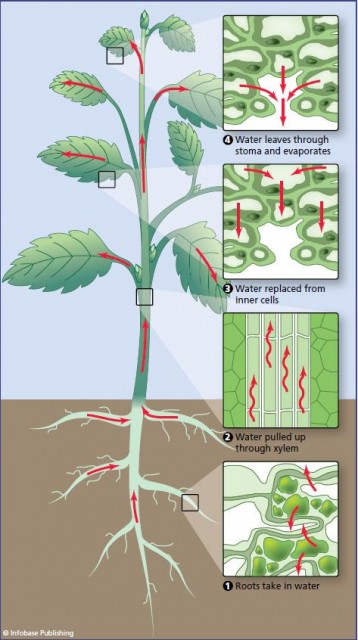Stephen Hales, the Movement of Sap, and Transpiration
On the surfaces of leaves there are small pores that open and close in response to the movements of two guard cells, one on either side of each pore. The pores are called stomata (singular stoma), and they are the openings through which the plant exchanges gases. Carbon dioxide enters the plant and is used in photosynthesis, and oxygen, a by-product of photosynthesis, leaves. While the stomata are open, water in the tissue immediately beneath the leaf surface is lost by evaporation, its place being taken by water drawn upward through the plant. This process is called transpiration. Marcello Malpighi was the first microscopist to see and describe the stomata, but he had no idea of their function. The first description of transpiration appeared in 1727, in a book entitled Vegetable Staticks written by an English clergyman Stephen Hales (1677–1761). Vegetable Staticks was the first volume of Hales's Statical Essays. The second volume, called Haemostaticks, dealt with animal physiology.
The following diagram shows the process of transpiration and the involvement of the stomata. The evaporation of moisture through the stomata draws up more water to replace it along an unbroken stream that extends all the way through the xylem vessels to the roots. In one of his experiments, Hales cut off a vine at ground level in spring before the buds had opened and attached a long glass tube, mounted vertically, to the severed stem. He found that the sap rose to a height of 24.9 feet (7.6 m). This demonstrated that there was a considerable pressure drawing it upward. His careful measurements of the flow of sap showed that it flows in one direction only, rather than circulating like the blood of a mammal.

This was only one of Hales's experiments with plants. He discovered that the amount of pressure drawing water into the roots varied through the day and according to the temperature. In March 1718 he was elected a fellow of the Royal Society, and in 1719 he presented a paper to the society “Upon the Effect of the Sun's warmth in raising the Sap in trees.” He suggested that plants very probably absorb some of their nourishment from the air, and he noted that leaves absorb light, which he found was necessary to their growth.
In addition to his physiological studies, Hales studied air and invented a device that allowed him to breathe only the air he had exhaled. He found he could do this for about one minute before feeling ill, but that if he added an alkaline substance to the apparatus he could continue breathing for more than eight minutes (because the alkali absorbed carbon dioxide, although Hales did not know this). These experiments alerted him to the danger of breathing stale air, and he invented a ventilator to remove stale air—he called it noxious air—from mines, ships, hospitals, and prisons. He considered his ventilator to be his greatest contribution to humanity. He also studied ways to preserve food and water on long ocean voyages and in hot climates.
Stephen Hales was born on September 17, 1677, at Beakesbourne, Kent. In 1697 he entered Bene't (now Corpus Christi) College, University of Cambridge, to study theology, graduating in 1700, receiving his master's degree in 1703, and graduating as a bachelor of divinity in 1711. He received his doctorate of divinity from Cambridge in 1733. While still a student, Hales developed an interest in astronomy, physics, and chemistry, but his attention was directed principally toward the physiology of plants and animals. Hales was ordained in 1703, and in 1709 he left Cambridge—where he had spent 13 years—to take up the position of perpetual curate at Teddington, Middlesex, where he remained for the rest of his life. From 1751 he also held court appointments, first as almoner (the official who distributes charity) to Augusta of Saxe-Gotha, the princess dowager of Wales, and subsequently as chaplain to the princess and to her son, who became George III. Hales was also rector of Porlock, Somerset, and Faringdon, Hampshire, where he spent his summer while spending the rest of the year at Teddington. In 1719 he married Mary Newce, who died in 1721. They had no children. Hales died at Teddington on January 4, 1761.
- Robert Hooke and the Cell
- Marcello Malpighi and the Microscopic Study of Plants
- Nehemiah Grew, Plant Reproduction, and Comparative Anatomy
- Nikolai Vavilov and the Origin of Cultivated Plants
- Gote Turesson and Plant Ecotypes
- Asa Gray and the Discontinuous Distribution of Plants
- Charles Darwin and Evolution by Means of Natural Selection
- Adolphe-Theodore Brongniart, Father of Paleobotany
- How Rubber Moved to Asia